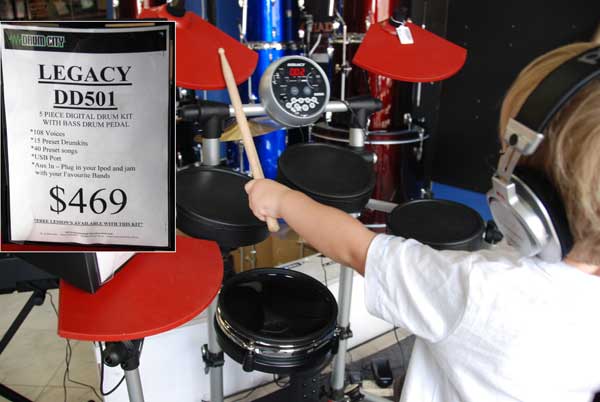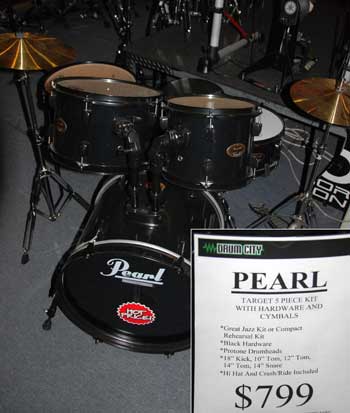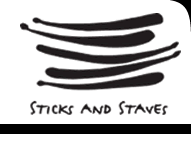Here is Matt Moore's advice on buying a beginner student drumkit. Please note prices will have changed because this article was written in 2010. When purchasing a drumkit for your son or daughter you should first decide which kind of drumkit will be better for your needs - acoustic or electronic. Both have advantages; the acoustic kit will be better for live performance and has a realistic feel, the electronic kit is perfect for quiet practice at home, and it's easy to do home recordings with. Another advantage is that you don't have to buy cymbals - all you need is a set of headphones, or an amp. If your son or daughter is left-handed it's probably best to purchase acoustic drums over electronic as these can be a pain to reconfigure. Next comes budget. I would first like to point out that it's NOT necessary to purchase a drumkit for the first few months. A practice pad will suffice ($20-30) and will allow you to gauge how serious the student is about learning and practising the instrument. There seem to be 3 levels of pricing in music shops: budget ($450-$800), student ($800-$2000) and professional ($2000+). For an acoustic kit you should add $200-$1000 for cymbals. Decide on your budget first to help narrow down the multitude of choices. Should you decide to sell the kit at a later stage, student and professional kits will sell for a good price, whereas budget kits will not. Electronic kits  When I tested some budget electronic kits, I was pleasantly surprised when I tested the cheapest one in the store, the Legacy DD501. (That's my enthusiastic 2 year old son in the photo). This kit is actually very good value for money. The sounds are OK and the drumkit plays nicely. Damien tells me it's the newest one in the Legacy range, so it has a very fast CPU. It's a good space saver - the whole thing is very compact, ideal for a house with limited space. The biggest downside is the small snare pad, which feels almost like you're playing into a mug filled with hard toffee. Also, the surfaces of the bass drum and snare drum are slightly too hard, and feel a little like you're playing on a board. But for $469 it's extremely good value. It also comes with a BD pedal, and you can plug your iPod in and play along. I would advise skipping the next few Legacy models - the DD502 ($800), DD505 ($870) and DD506 ($1050), simply because the pads are way too spongy and don't allow players to practice intricate stick techniques such as buzz rolls. (On the upside though, there's less annoying 'tick tick' sound of stick-on-rubber). Which brings us to the next Legacy model, the DD508 ($1250). Decent hard rubber pads. Good sounds, and one extra tom and cymbal pad. Reminds me of my Roland TD20 setup, but a budget version. This kit is highly recommended. Anything above this price range you're getting into Roland and Yamaha electronic kits, which you are free to explore for yourself. Acoustic kits There are two things to think about with acoustic kits - your budget (which corresponds to quality), and drum sizes. The two main sizes of drumkits are - 'Fusion' and 'Traditional'. The difference is in the diameter of the drums. 'Fusion' kits are smaller and sound better for a wider range of playing styles (rock, jazz, latin etc.) and are great for young students because because they don't have to reach as far to hit anything. 'Traditional' sizes are bigger and have nice low sounding toms which are especially good for styles such as rock and heavy metal. Let me point out the main things I always look for in a kit:
1. Legs on the floor tom. A MUST HAVE for students and pros alike!!! A suspended floor tom will drive students crazy trying to position the floor tom while it's attached to a cymbal stand. If the kit has a suspended floor tom, think seriously before buying it! If you really can't resist the temptation though, and you start getting complaints about positioning problems (or the whole structure constantly falling over), you could always consider giving Rhythm Restorations (Sydney) a call for a conversion www.rhythmrestorations.com.au - will cost $60 for parts and $30 to fit.
2. Shell composition. Maple, Oak and Birch are the ultimate timbers for great sounding drums, but student kits tend to have some degree of Mahogany, Poplar or Basswood in them. The really cheap ones are constructed from generic timber.
3. Cymbals. Most drumkits either come with really cheap and nasty cymbals (like in the picture below) which are NOT recommended if the student is trying to practise cymbal techniques learnt during their drum lessons. Pro kits don't come with any cymbals at all. Either way, you will need to buy some cymbals!!! Rather than choosing individual cymbals, the easiest solution for beginners is to buy a cymbal pack. The better-sounding ones are often pricey, and for some models the money you have to outlay is not in proportion to the quality of sound produced. Damien showed me the 'Stagg YR Cast Made cymbal pack' - only $189, but cast-made rather than sheet metal, and hand-hammered like pro cymbals - the rich dark sound of cymbals such as these are very popular amongst pro drummers. Even compared to a $1400 'Zildjian A Custom' pro cymbal pack, the Stagg cymbals hold their own and are great value.
4. Heads (skins). As with any beginner kit, the heads are often the worst part about them. I would HIGHLY recommend spending an extra $80 on a pack of 'Pinstripe' heads to replace the existing heads. It will be so much more inspiring for the student to practise on. (This pack is great value - you usually pay over $30 per head)
5. A spiral stool. If your kit doesn't come with a stool, consider buying a SPIRAL stool. Even the cheapest spiral stools are reliable and won't collapse or start sinking. Also, there are unlimited height adjustment possiblities.
6. A toothless snare stand. I prefer a toothless snare stand because of the minute adjustments you can make to the angle of your snare drum, which is really important when adjusting the angle to play rimshots (when you play the head and the rim together). Fine-toothed stands are OK, but the really course-toothed stands annoy me because you end up compromising the angle of your snare drum.
7. Cymbal stands. Drumkits always come with at least one cymbal stand, but if you require more you can always buy extra (generic) ones fairly cheaply. Choose between straight, and boom (with an arm). The cheapest kits are from China, but don't go rushing out to buy one of these. Think carefully before you purchase - there are a million brand new cheap and nasty drumkits out there. There are no known 'brand' names at this price level, but you'll find things like 'Sonic Drive' drumkits for $499. At this price though it will be harder to tune the drums nicely, and the hardware (stands/nuts and bolts) will probably start to fall apart after a while. Resale value is not good either.  The next step up is a 'practise drumkit'. Pearl have a nice little practise kit called 'Target' retailing at $799, pictured here. At $1149, The Pearl 'Forum' is worth a look, and you get an extra tom for that price. If budget allows, take a good look at the following two drumkits: Pearl 'Vision' drum kit (which replaces the old Export) and PDP Pacific drums (with Maple shells), both around $1800. I would recommend either one, and both have great resale value. Above $2000 you get into pro drum territory, which I won't go into here. You can also find great bargains when purchasing decent quality drumkits second-hand on eBay or similar websites (I bought my present drumkit from Gumtree for less than half the retail price). I'd recommend that you do some website research on retail prices for comparison. I always recommend the student plays a kit before purchasing, to see if it sounds good and is right for their needs. That about wraps it up. If you are a parent of one of our students and have any comments or questions, please feel free to ask info@sticksandstaves.com. | 